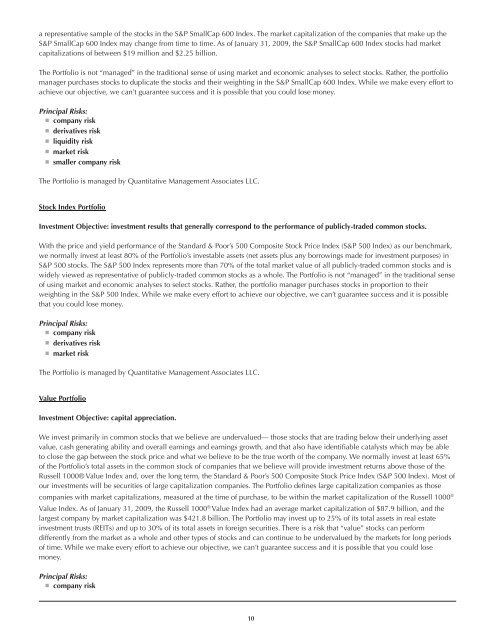The Prudential Series Fund
The Prudential Series Fund
The Prudential Series Fund
You also want an ePaper? Increase the reach of your titles
YUMPU automatically turns print PDFs into web optimized ePapers that Google loves.
a representative sample of the stocks in the S&P SmallCap 600 Index. <strong>The</strong> market capitalization of the companies that make up the<br />
S&P SmallCap 600 Index may change from time to time. As of January 31, 2009, the S&P SmallCap 600 Index stocks had market<br />
capitalizations of between $19 million and $2.25 billion.<br />
<strong>The</strong> Portfolio is not “managed” in the traditional sense of using market and economic analyses to select stocks. Rather, the portfolio<br />
manager purchases stocks to duplicate the stocks and their weighting in the S&P SmallCap 600 Index. While we make every effort to<br />
achieve our objective, we can’t guarantee success and it is possible that you could lose money.<br />
Principal Risks:<br />
■ company risk<br />
■ derivatives risk<br />
■ liquidity risk<br />
■ market risk<br />
■ smaller company risk<br />
<strong>The</strong> Portfolio is managed by Quantitative Management Associates LLC.<br />
Stock Index Portfolio<br />
Investment Objective: investment results that generally correspond to the performance of publicly-traded common stocks.<br />
With the price and yield performance of the Standard & Poor’s 500 Composite Stock Price Index (S&P 500 Index) as our benchmark,<br />
we normally invest at least 80% of the Portfolio’s investable assets (net assets plus any borrowings made for investment purposes) in<br />
S&P 500 stocks. <strong>The</strong> S&P 500 Index represents more than 70% of the total market value of all publicly-traded common stocks and is<br />
widely viewed as representative of publicly-traded common stocks as a whole. <strong>The</strong> Portfolio is not “managed” in the traditional sense<br />
of using market and economic analyses to select stocks. Rather, the portfolio manager purchases stocks in proportion to their<br />
weighting in the S&P 500 Index. While we make every effort to achieve our objective, we can’t guarantee success and it is possible<br />
that you could lose money.<br />
Principal Risks:<br />
■ company risk<br />
■ derivatives risk<br />
■ market risk<br />
<strong>The</strong> Portfolio is managed by Quantitative Management Associates LLC.<br />
Value Portfolio<br />
Investment Objective: capital appreciation.<br />
We invest primarily in common stocks that we believe are undervalued— those stocks that are trading below their underlying asset<br />
value, cash generating ability and overall earnings and earnings growth, and that also have identifiable catalysts which may be able<br />
to close the gap between the stock price and what we believe to be the true worth of the company. We normally invest at least 65%<br />
of the Portfolio’s total assets in the common stock of companies that we believe will provide investment returns above those of the<br />
Russell 1000® Value Index and, over the long term, the Standard & Poor’s 500 Composite Stock Price Index (S&P 500 Index). Most of<br />
our investments will be securities of large capitalization companies. <strong>The</strong> Portfolio defines large capitalization companies as those<br />
companies with market capitalizations, measured at the time of purchase, to be within the market capitalization of the Russell 1000 ®<br />
Value Index. As of January 31, 2009, the Russell 1000 ® Value Index had an average market capitalization of $87.9 billion, and the<br />
largest company by market capitalization was $421.8 billion. <strong>The</strong> Portfolio may invest up to 25% of its total assets in real estate<br />
investment trusts (REITs) and up to 30% of its total assets in foreign securities. <strong>The</strong>re is a risk that “value” stocks can perform<br />
differently from the market as a whole and other types of stocks and can continue to be undervalued by the markets for long periods<br />
of time. While we make every effort to achieve our objective, we can’t guarantee success and it is possible that you could lose<br />
money.<br />
Principal Risks:<br />
■ company risk<br />
10
















